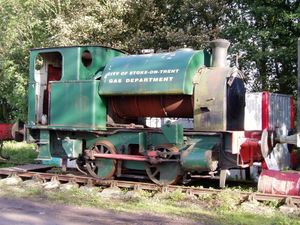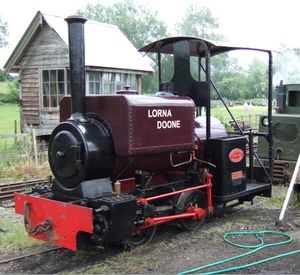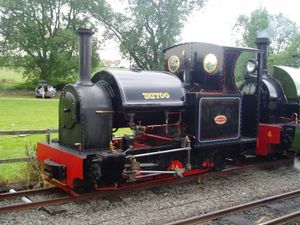Kerr Stuart

Kerr Stuart & Co Ltd was a locomotive manufacturer from Stoke-on-Trent, England. It was founded in 1881 by James Kerr as James Kerr & Co., and became Kerr, Stuart & Co from 1883 when John Stuart was taken on as a partner. The business started in Glasgow, Scotland, but during this time they were only acting as agents ordering locomotives from established manufacturers, among them Falcon, John Fowler and Hartley, Arnoux and Fanning. They bought the last-named company in 1892 and moved into the California Works in Stoke to begin building all their own locomotives. Hartley, Arnoux and Fanning had also been building railway and tramway plant. This side of their business was sold to Dick, Kerr and Co. in Preston.
Contents
Kerr Stuart Standard Designs
Kerr Stuart were known for producing a number of standard designs with many engines being built for stock and sold 'off the shelf' to customers. The names of these locomotive types were often derived from the purchaser of the first of that type or from the name it was given.
The Kerr Stuart designs are typified by having a single trailing truck (allowing a large firebox to be placed behind the driving wheels) and/or having a saddle tank. Several designs of side tank locomotive were produced that shared a chassis and boiler with a saddle tank design and it is not unknown for a standard chassis from one design to used with a different design's standard boiler to produce a locomotive to suit a customers special requirements.
Standard gauge designs
| Name | Wheel
arrangement |
Weight | Notes |
|---|---|---|---|
| Huxley | 0-4-0ST | 16 Tons | |
| Witch | 0-4-0ST | 16 Tons | |
| Rugeley | 0-6-0ST | 31 Tons | |
| Priestley | 0-4-0WT | 25.5 Tons | |
| Moss Bay | 0-4-0ST | 29 Tons | named after Moss Bay Haematite Iron & Steel Co Ltd, Workington) |
| Argentina | 0-6-0T | 34 Tons | |
| Victory | 0-6-0T |
Narrow gauge designs
| Name | Wheel
arrangement |
Weight | Notes |
|---|---|---|---|
| Wren | 0-4-0ST | 3.5 Tons | |
| Sirdar | 0-4-0T | 6.5 Tons | |
| Tattoo | 0-4-2ST | 6 Tons | Two examples survive in the UK Edward Thomas on the Talyllyn Railway and Stanhope; several remain preserved in Burma at the Burma Mines Railway |
| Huxley | 0-4-2T | At least one survives in working order on the Burma Mines Railway | |
| Skylark | 0-4-2T | 10 Tons | |
| Darwin | 0-4-2ST | ||
| Joffre | 0-6-0T | named after Joseph Jacques Césaire Joffre; the Joffre class was a French Decauville design built by KS under contract during the Great War; several examples have been re-imported into the UK, including Axe on the Lynton & Barnstaple Railway | |
| Haig | 0-6-0T | named after Douglas Haig, 1st Earl Haig); the Haig class was developed from the Joffre as a result of parts being left unused at the end of the Great War. Two examples survive in New Zealand, and one - Sergeant Murphy - on the Teifi Valley Railway | |
| Brazil | 0-4-2ST | 14.5 Tons | Several examples survive, including Excelsior on the Great Whipsnade Railway and three locos of the Sittingbourne & Kemsley Light Railway |
| Waterloo | 0-4-2ST | 15 Tons | |
| Barreto | 0-6-2T | 10 Tons | At least one example survives, Superior on the Great Whipsnade Railway |
| Matary | 0-6-2T | 17.5 Tons |
Steam Rail Motors
Kerr Stuart had a large joiners shop and a significant passenger coach construction business. They were therefore very well placed to build the steam railcar. Their first was a diminutive 2 ft (610 mm) gauge saloon for the Maharajah of Gwalior in 1904 followed by a batch of 11 standard gauge railcars in 1905, six for the Taff Vale Railway, two for the Lancashire and Yorkshire Railway, two for the Great Western Railway and one for the Great Indian Peninsula Railway. The GWR gave a repeat order in 1906 for a further 12 slightly more powerful units. The largest rail motor order was for 15 from the Italian State Railways.
Custom Built Designs
In addition to the company's standard designs the company accepted many orders to build to the customers' own designs in all gauges. The California works produced in 1903/4 a 4-6-0 design for several Irish 3 ft (914 mm) gauge lines including a 4-6-2T version for the Londonderry and Lough Swilly Railway. For Chile a very large 3 ft 6 in (1067 mm) gauge double six-coupled bogie Meyer followed in 1904 by five American style bar-framed 2-8-0 tender engines for the 3 ft (914 mm) gauge Interocianic and Mexican Eastern Railways. In May 1910 they built a 2 ft (610 mm) gauge "modified Fairlie" for service in Madras. This was not a Fairlie but just two 0-4-2T engines permanently coupled back to back, the only articulation being between the two complete engines. They received a repeat order for this combination.
A truly remarkable standard gauge build of 1910 was a class of four handsome 4-2-2 express passenger locomotives to the design of E.J. Dunstan for the Shanghai Nanking Railway. The order was received on April 19 1910 and the novel design required the production of totally new drawings and patterns for all parts. Even so, the first engine was steamed just seven weeks later on June 8 1910. In service these engines, probably the last, and the biggest, single driver engines ever built, proved to be fast (60 m.p.h.), smooth running, and very economical on fuel when compared with similar 4-4-0 engines on the same line.
From the 2 ft (610 mm) gauge Gwalior Light Railway in India, the company received several orders for locomotives and a wide variety of rolling stock over the years, culminating in the construction of four large 2-8-2 tender engines in 1928. Six very powerful superheated 4-8-0 mixed traffic locomotives built in 1929 were the last of a series of 4-4-0 and 4-6-0 machines built for the Buenos Aires Central Railway of Brazil.
In common with most British locomotive builders, in the post war era Kerr Stuart received a number of large orders from the mainline companies who were seeking to replace obsolete inherited equipment with their own standard designs. In 1920 the Metropolitan Railway ordered eight superheated 4-4-4 passenger tank engines for the Aylesbury service. Between 1925 and 1927 the Stoke works built 50 standard class 4F 0-6-0 goods engines for the London Midland and Scottish Railway and in 1929 and 1930 a batch of 25 GWR 5700 Class 0-6-0PTs were built for the Great Western Railway.
Diesel Locomotives
In the late 1920s a number of diesel locomotives were built of 30hp, 60hp and 90hp. They were very successful even though technology moved on quickly. Further development was stopped when Kerr Stuart's went into receivership, but the Hunslet range of diesel locomotives was based on these. At least 3 Kerr Stuart diesel locomotives have survived into preservation but none is in original condition having been given different engines.
The Company in Liquidation
In 1930 the firm's goodwill (Designs, spare parts, etc) was bought by the Hunslet Engine Company.
Some locomotives were built by W. G. Bagnall to Kerr Stuart designs. This is a result of the chief Kerr Stuart Draughtsman, and a number of other staff, being employed by Bagnalls. These locomotives include examples of the Haig and Matary classes.
The last steam locomotive built in Britain for industrial use, was a Hunslet built "Brazil" class engine in 1971. This locomotive is now running on the private Statfold Barn Railway.
The Corris Railway commissioned a new locomotive based on the "Tattoo" design of its original No.4 (KS4047) and this was privately built over a ten year period and went into service in 2005 as No.7.
Preservation
| Location | Class | Name | Works Number | Built | Arrangement | Gauge | Notes |
|---|---|---|---|---|---|---|---|
| West Lancashire Light Railway | Tattoo | Stanhope | 2395 | 1917 | 0-4-2ST | 2 ft (610 mm) | ex. Penrhyn Quarry Railway |
| Amerton Railway | Wren | Lorna Doone | 4205 | 1922 | 0-4-0ST | 2 ft (610 mm) | |
| Brecon Mountain Railway | Sirdar | Diana | 1158 | 0-4-0T | 2 ft (610 mm) | ex Kerry Tramway | |
| Buckinghamshire Railway Centre | GWR 5700 | 0-6-0PT | Template:4ft8in | ||||
| Buckinghamshire Railway Centre | 90hp Diesel | 4wDM | Template:4ft8in | Heavily rebuilt | |||
| Cavan & Leitrim Railway | Drummond | 3024 | 1916 | 0-4-2T | 3 ft (914 mm) | ||
| Corris Railway | Tattoo | No. 7 | 2005 | 0-4-2ST | 2 ft 3 in (686 mm) | Design based on the railway's original Tattoo (KS4047), now running on the Talyllyn Railway | |
| Foxfield Light Railway | Witch | 0-4-0ST | Template:4ft8in | ||||
| Foxfield Light Railway | 90hp Diesel | 6wDM | Template:4ft8in | Re-engined | |||
| Great Whipsnade Railway | Brazil | Excelsior | 1049 | 1908 | 0-4-2ST | 2 ft 6 in (762 mm) | ex. Bowaters Railway |
| Great Whipsnade Railway | Barretto | Superior | 4034 | 0-6-2ST | 2 ft 6 in (762 mm) | ex Bowaters Railway | |
| Leighton Buzzard Railway | Wren | Pixie | 0-4-0ST | 2 ft (610 mm) | |||
| Lynton and Barnstaple Railway | Joffre | Axe | 2451 | 0-6-0ST | 2 ft (610 mm) | ||
| Owned by Graham Morris | Wren | Peter Pan | 0-4-0ST | 2 ft (610 mm) | |||
| Moseley Railway Trust | Joffre | 3014 | 0-6-0T | 2 ft (610 mm) | ex. Gloddfa Ganol | ||
| Narrow Gauge Railway Museum | 721 | 0-4-0WT | {2ft6in}} | ex. Dundee Gasworks | |||
| Ocean Beach Railway Dunedin, New Zealand | Haig | 4185 | 0-6-0T | ||||
| Paraparamu New Zealand | Haig | 4183 | 0-6-0T | On display outside a Macdonald's restaurant | |||
| Sandstone Steam Railway | Wren | Little Bess | 4031 | 1919 | 0-4-0ST | 2 ft (610 mm) | |
| Sandstone Steam Railway | 4063 | 1924 | 0-4-2PT | 2 ft (610 mm) | |||
| Sandstone Steam Railway | 1344 | 1913 | 4-6-2T | 2 ft (610 mm) | |||
| Sittingbourne & Kemsley Light Railway | Brazil | Leader | 0-4-2ST | 2 ft 6 in (762 mm) | |||
| Sittingbourne & Kemsley Light Railway | Brazil | Premier | 0-4-2ST | 2 ft 6 in (762 mm) | |||
| Sittingbourne & Kemsley Light Railway | Brazil | Melior | 0-4-2ST | 2 ft 6 in (762 mm) | |||
| Severn Valley Railway | GWR 5700 | 0-6-0PT | Template:4ft8in | ||||
| Statfold Barn Railway | Brazil | Trangkil No.4 | 3902 | 1971 | 0-4-2ST | 2 ft (610 mm) | The last industrial steam locomotive built in Britain, regauged from 2 ft 6 in (762 mm) gauge. |
| Talyllyn Railway | modified Tattoo | Edward Thomas | 4047 | 1921 | 0-4-2ST | 2 ft 3 in (686 mm) | ex Corris Railway |
| Teifi Valley Railway | Haig | Sgt. Murphy | 0-6-2ST | 2 ft (610 mm) | ex. Penrhyn Quarry Railway, Heavily rebuilt | ||
| Teifi Valley Railway | Joffre | 0-6-0ST | 2 ft (610 mm) | ex. Gloddfa Ganol | |||
| Vale of Rheidol Railway | Wren | Brockamin | 0-4-0ST | 2 ft (610 mm) | |||
| Welsh Highland Railway | 60hp Diesel | 4115 | 6wDM | 2 ft (610 mm) | One of the earliest diesel locomotives in existence | ||
| Welshpool and Llanfair Light Railway | modified Matary | Joan | 1929 | 0-6-2ST | 2 ft 6 in (762 mm) | Originally operated in Antigua | |
| West Lancashire Light Railway | Joffre | Joffre | 2405 | 0-6-0WTT | 2 ft (610 mm) | ||
| unknown | Joffre | 3010 | 0-6-0T | 2 ft (610 mm) | ex. Gloddfa Ganol, now stored at the Yaxham Light Railway |
References
- Horsman, Geoffrey (December 1964). ""The Kerr Stuart Wren Class"". The Industrial Railway Record (Nos 5 & 6): 85-99.
- L.T.C. Rolt, A Hunslet Hundred, David & Charles, 1964, (Kerr Stuart & Company - pages 86-101).


